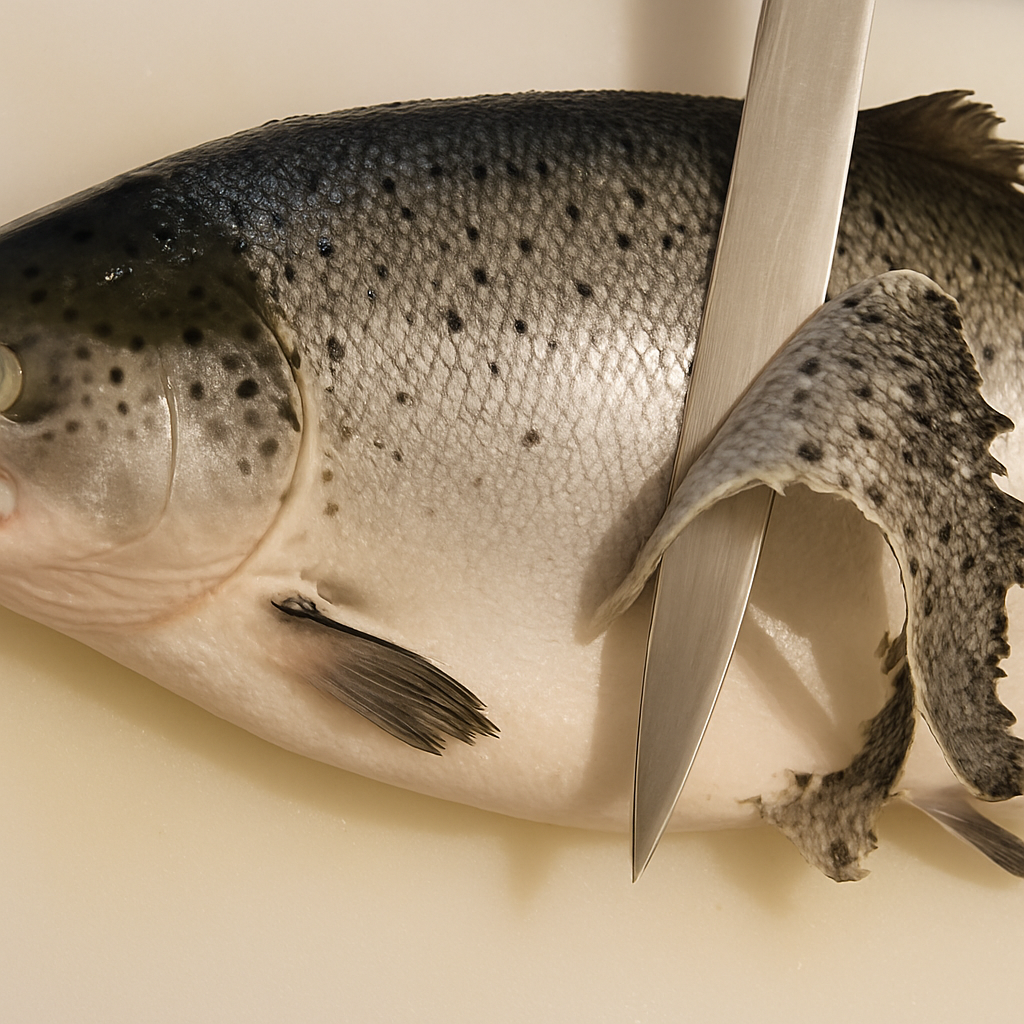Sukibiki: The Japanese Scaling Technique That Protects Premium Fish
Sukibiki is a traditional Japanese scaling technique that cuts scales away rather than scraping them off, preserving the delicate flesh of premium fish.

Walk into any high-end sushi restaurant in Tokyo and you might notice something unusual—the chefs aren't using regular fish scalers.
Instead, they're carefully drawing knives across the fish's skin in precise, measured strokes.
This is sukibiki (すきびき), a traditional Japanese scaling technique that cuts scales away rather than scraping them off, preserving the integrity of fish that might be worth thousands of dollars.
While it shares philosophical similarities with katsuramuki, the rotary peeling technique that transforms daikon radish into continuous translucent sheets where sukibiki applies this principle of controlled cutting to the more delicate task of removing fish scales without damaging the precious flesh beneath.
What Makes Sukibiki Different
Unlike conventional scaling that involves aggressive scraping, sukibiki removes scales through controlled cutting motions.
The technique cuts away scales along with a paper-thin layer of skin using a sawing motion—it's more demanding but infinitely gentler on delicate fish flesh.
The name reveals the technique's essence: "suki" relates to thinning or shaving, while "biki" means to pull or draw.
Together, they describe the precise motion of drawing the knife across the fish at just the right angle to separate scales from flesh without cutting too deep.
Why does this matter? Traditional scalers can bruise flesh and damage internal organs, especially on softer fish.
For premium specimens like winter yellowtail or wild hiramasa that fetch top dollar at market, such damage is simply unacceptable. Sukibiki preserves the fish's pristine condition from the very first step of preparation.
Which Fish Need Sukibiki
Not every fish requires this delicate treatment—sukibiki is reserved for species where conventional scaling would compromise quality.
Yellowtail (Buri): These prized fish have extremely fine scales that must be removed using sukibiki. Winter yellowtail (kan-buri), which can weigh over 8 kilograms, demands especially careful handling to preserve its rich, fatty flesh that commands premium prices.
Fluke (Hirame): Essential to traditional Edomae sushi, these flatfish have delicate white flesh that bruises easily. Sukibiki preserves the subtle sweetness and oceanic flavors that make hirame so valued.
Sea Bass (Suzuki) and Fine-Scaled Fish: Fish with particularly small scales often get damaged by traditional scalers, which either miss scales or tear skin trying to remove them. Sukibiki's cutting action ensures complete, clean removal without damage.
The technique also works perfectly for premium specimens being prepared for dry aging—a increasingly popular practice in high-end establishments.
The Right Tools for the Job
Sukibiki success depends entirely on having the proper knife and keeping it razor-sharp. Most chefs use one of three options:
- Sujihiki: The most common choice—a long, narrow slicing knife that follows the fish's natural contours
- Yanagiba: Some prefer their sashimi knife, especially for smaller fish
- Deba: The Japanese butcher knife works well for fish with tougher scales
Many sushi chefs keep a dedicated "beater" knife just for sukibiki—sharp enough for the task but not their premium sashimi blade.
Since repeated contact with scales dulls even the finest steel, this preserves their expensive knives while maintaining the precision sukibiki demands.
Sharpness isn't negotiable. A sharp knife cuts scales away with minimal pressure, while a dull blade requires force that risks tearing skin or cutting flesh.
The entire blade length must be sharp, including the tip, especially when working with smaller fish.
How to Execute Sukibiki
Timing matters—always scale before gutting. The intact fish body provides necessary resistance against the knife's pressure, preventing the flesh from collapsing during scaling.
Once you remove the internal organs, the stomach collapses into the cavity, making proper sukibiki nearly impossible.
The Setup: Position the fish with its head to the right (for right-handed practitioners).
Using scissors, remove any fins that might interfere—typically everything except the tail, which provides a useful grip.
The Technique: Starting at the tail and working toward the head, use long, continuous strokes.
This isn't a simple scrape but a controlled sawing motion that shaves away scales with the thinnest possible layer of skin.
Hold the knife at 15-30 degrees, angling it slightly upward so if it catches, it won't dig into the flesh.
The belly and areas near the dorsal fins prove trickiest. These spots often require repositioning both fish and cutting board—some chefs even move their setup to the table's edge, positioning their hand below the board level to achieve the proper angle.
Maintaining Control: If you feel resistance, your knife might be dragging scales along.
Stop, wipe the blade clean, and wet it slightly—the water acts as lubricant for smoother cutting.
For slippery fish, place damp paper towel between the fish and cutting board to prevent sliding.
Why Modern Chefs Choose Sukibiki
Beyond preserving fish quality, sukibiki has found new purpose in contemporary techniques.
Dry-aging fish has become increasingly popular in high-end restaurants, and sukibiki proves essential for this process.
Traditional scaling leaves tiny pores where scales attached to the skin. During aging, water pools in these pockets, creating perfect breeding grounds for bacteria.
Sukibiki eliminates these pockets entirely, creating the smooth surface necessary for safe, controlled aging.
Efficiency improves dramatically with mastery. An experienced chef can completely scale a yellowtail in under 10 minutes with a sharp knife—the same task might take 30 minutes with dull tools or poor technique.
This speed matters when processing multiple premium fish daily.
Some establishments now require sukibiki for all high-value fish. The technique has become a mark of quality, distinguishing restaurants that invest in proper fish handling from those taking shortcuts.
The Philosophy Behind the Blade
Sukibiki embodies the Japanese principle of treating ingredients with ultimate respect.
By investing time and skill in properly scaling fish, chefs demonstrate commitment to revealing each ingredient's full potential.
This approach contrasts sharply with faster methods that prioritize efficiency over quality.
The technique also reflects "shokunin"—the craftsman's dedication to perfection through repetitive practice.
Masters of sukibiki join a lineage stretching back generations, each practitioner adding personal understanding while preserving core principles.
In high-end sushi restaurants, diners might never know their fish was scaled using sukibiki.
Yet the technique's effects—pristine flesh, perfect texture, optimal aging—manifest in every bite. This invisible excellence defines Japanese haute cuisine, where the most important work often goes unseen.
Final Thoughts
Sukibiki represents more than just a scaling method—it's a philosophy expressed through blade work.
In a world where premium fish command extraordinary prices, this technique ensures every specimen reaches its full potential, unmarred by careless preparation.
For top sushi chefs, sukibiki isn't optional but essential. It preserves fish that might have traveled thousands of miles, ensuring they reach the plate in perfect condition.
As global appreciation for authentic Japanese cuisine grows, sukibiki stands as testament to uncompromising standards.


